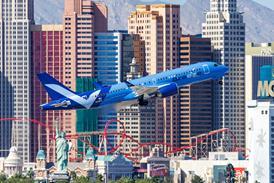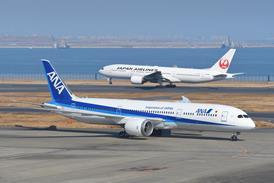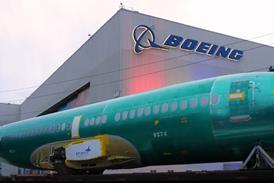Apart from delaying the traditional seasonal peak, SARS left the cargo sector relatively unscathed. Some think it is about to enter a new boom period
The early part of September was an anxious time for the world's air cargo industry as the normal surge in traffic that signals the start of the pre-Christmas peak season did not arrive. 'The peak is arriving about four weeks late this year,' was the universal cry of airline cargo managers from Minneapolis to Singapore.
By late September, however, traffic was picking up, prompting most cargo managers to speculate that the hold-up was just an after-effect of the SARS crisis. 'It is all due to delayed buying trips from the retailers,' says Jim Friedel, president of the cargo division at Northwest Airlines. 'These folks normally go to Asia in May and June to place orders for the peak, but many companies banned travel to Asia during that time. So the trips didn't happen until July and August.'
If SARS was to blame for the delayed start to the peak, then it is one of the more pronounced effects that the crisis has had on air cargo. That is because, unlike the passenger side of the business, cargo was not vastly affected by the SARS scare. Just as cargo was not afraid to fly after the events of 11 September, it was also not worried about catching SARS.
True, Hwang Teng Aun, president of Singapore Airlines Cargo (SIA Cargo), says that 'at the height of the epidemic you could hear a pin drop on Orchard Road', Singapore's main shopping street, but in fact his cargo tonnage was not nearly as badly affected as the passenger business. The main impact came from cuts in passenger flights, which reduced belly capacity, and inevitably led to some cargo being turned away. 'At one point, our belly capacity was down 40%, but we just worked our freighters harder - harder than we have ever worked them before, in fact,' says Hwang.
Capacity cuts
Despite being in the eye of the SARS storm, Kenny Tang, general manager for cargo at Cathay Pacific, also says it was capacity cuts rather than a drop in demand that cost it business. 'The USA still kept buying, and there was no cut in orders. The cut in passenger schedules was the main headache,' he says.Industry statistics bear this out. IATA shows Asia-Pacific cargo traffic up 13% for May and 10% in June. Members of the Association of Asia Pacific Airlines recorded static volumes in May and a 5% rise in June, while Europe's mainline carriers showed only a slight dip to Asia going into the summer and the US majors held transpacific volumes steady.
These are figures to make the passenger side of the business weep, and there is no doubt that for all carriers Ð but particularly Asian ones Ð cargo gained in profile as a result of the crisis. As Tang points out, in the first six months of 2003, cargo accounted for 36% of total revenue at Cathay, against 27% the year before. And it achieved this despite a 4.1% revenue drop.
Looking forward, the immediate question is the perennial one of how strong the peak season will prove. For almost certain it will not be as good as last year's peak. Figures for the Top 100 Cargo Carriers suggest that traffic grew by close to 8% last year, although revenues were up by a slightly more modest 6% as yields fell. The world's airports also reported a 4% rise in tonnages last year, with Asia posting double-digit growth A labour dispute at ports on the US West Coast helped in the second half, as shippers scrambled for air cargo capacity across the Pacific, as well as from Asia to Europe and on to the USA. But Hwang speaks for most when he says: This year we won't have the same kind of ramp up. There will be a seasonal spike, but not as pronounced as last year.'
Recovery ahead?
Other airline cargo managers too are cautious on the bigger question of whether this is the start of a long-awaited big recovery in air freight. After several previous hopes were disappointed, everyone is reluctant to say so this time. 'Everything seemed to be ramping up last year, but then hopes were dashed,' says Ram Menen, director of cargo at Emirates, which nevertheless showed traffic up by a third.
Menen does see hopeful signs, however. 'The inventory-to-sales ratio is down, and that normally means an upsurge in air cargo. It has not happened yet, but we can already see signs of Asia coming up. Where the bounce has not happened yet is in Europe and America, but the weaker dollar will produce more exports in time.
Phil Sims, director of cargo at IATA, speaks for many in the industry when he predicts steady improvement in 2004, with perhaps 5% growth. Lufthansa, which analyses seven key air freight markets in its AirDex index, is more cautious. It is generally bearish on Europe, moderately hopeful about North America, and predicts booming volumes out of India and Korea, although only slow growth out of Japan.
But behind this public caution, there is also some private optimism. There is a definitely a sense that freighter capacity is being ramped up worldwide. Emirates, until recently a mainly belly-focused carrier, recently leased its third full-time freighter, and is part-using a fourth. Korean Air took delivery of a Boeing 747-400ERF in June and has two more coming in February and November.
British Airways, which, like Emirates, until recently did not see freighters as a core offering, also added a third leased 747-400F in August. Keith Packer, senior vice-president global sales and marketing for cargo, is bullish: We are optimistic. We have seen no major downturn and are putting on additional capacity. We would not be doing this if we had not been seeing increased demand.'
United Airlines too, despite its Chapter 11 status, has big plans on the freighter front. Although it failed to launch a service in time for this year's peak season, vice-president for cargo Roger Gibson sees big opportunities for freighter services, with his eye particularly on China and Latin America. He even hints that passenger routes may be changed into freighter ones in China.
Bounce-backThere are varying reasons for these capacity upgrades. Menen admits that Emirates is positioning for the arrival of A380 and A340-500 aircraft in the next few years, which will paradoxically reduce the carrier's available belly capacity. Gibson sees freighters as essential to meet the increasing demand from forwarders for guaranteed capacity. But another factor is also a desire by carriers to position themselves for an anticipated bounce-back. 'I think the market is going to be strong, so we are putting the right capacity in the right place,' Menen says.
On the subject of guaranteed capacity - forwarders guaranteeing to pay for space, whether they use it or not in return for fixed rates - one interesting question is whether the fluctuations of the past two years have driven freight forwarders to increasingly seek this kind of deal. Hwang thinks they have.
Ever since SIA Cargo become independent two years ago, Hwang has been trying to get more commitments out of forwarders in order to justify the cost of operating freighters. At first forwarders were reluctant, but events such as SARS and the US West Coast ports dispute have changed all that, he says. 'Suddenly forwarders and shippers have realised that maybe they should hedge a bit so that they don't get caught out if there is a capacity crunch,' he says. Capacity agreements, which fix a price and also give carriers a baseload they can rely on, fit the bill.
If this trend becomes general, then it would tend to favour freighter operators, which have proved in the past two years that they are more reliable in times of trouble than belly cargo. For Korean, Emirates, United and British Airways that would certainly be welcome news.
PETER CONWAY LONDON
Source: Airline Business























